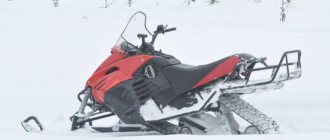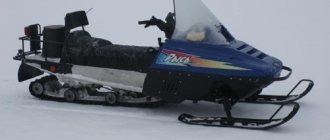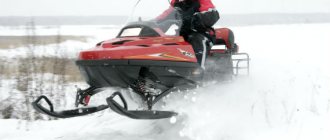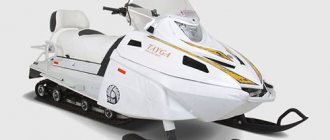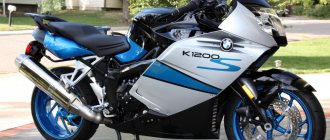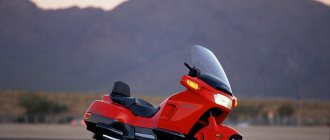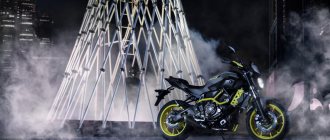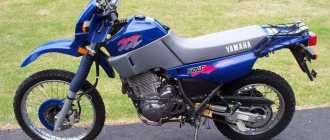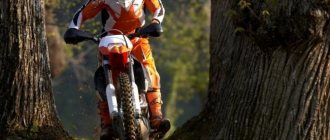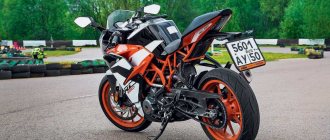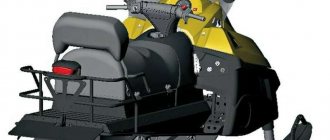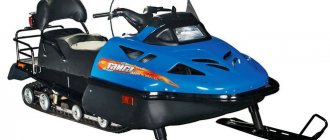Snowmobiles of the Tundra series are produced by one of the leading manufacturers of equipment for work and recreation? by BRP, founded by Canadian entrepreneur Bombardier. This son of a simple farmer gravitated toward technology since childhood, and after acquiring a small garage, he began to design new models on his own. He was especially attracted to tracked vehicles.
It is not surprising that Bombardier was the first to develop transport for winter travel. The snowmobile track system is still exactly as the company founder designed it. The high reliability and efficiency of the equipment produced allowed BRP to take a leading position in the production of ATVs, jet skis, all-terrain vehicles, and snowmobiles.
Specifications
The first generation of Ski-doo Tundra remained unchanged on the assembly line until 2006. The engine was weaker than the current version, the power was not enough to reach high speeds, but the snowmobile could also pass in hard-to-reach places, there was enough traction.
The 2nd generation models do not have any common features with their successor (except for the 500 cc Rotax engine), the technical specifications have changed, and a new wishbone front suspension has been built into the updated model.
Specifications table
| Engine | Rotax 600 4tec ace, volume 600, two-cylinder 57 l/s, four-stroke with oil cooling radiator. |
| Equipment | Straight Steel steering wheel, 205 mm height spacer, towbar, panel with digital display. |
| Platform | REW-XU |
| Transmission | Liquid cooling with drive and driven variator pulleys. |
| Suspension | Type LTS, Motion Control shock absorbers, front suspension travel 150 mm, rear suspension 381 mm. Type: 381. Ski doo tundra 600 is offered with 2 types of front suspension: telescopic and lever. |
| Dimensions and weight | 229 kg, width and height 1002/3329, caterpillar 3923/406, lug height 38 mm, fuel tank 40 l, oil tank 3.7 l. |
When the Tundra it 600 ace model received a new design and a modern REV-XU aluminum frame, BRP specialists decided to abandon the new “multi-link”, choosing the old type of suspension, which is built only on telescopic shock absorbers.
The new Tundra Skido 600 model has a throttle trigger, which can be changed on the steering wheel without the use of a professional tool. But you need to be more careful with him.
Transmission
This part of the device has the following characteristics:
- reverse;
- low gear;
- hydraulic brake system.
The lightweight, utilitarian type of vehicle has good maneuverability and can handle any forest with loose snow.
Dimensions and weight
Dimensions:
- length – 3236 mm;
- width – 1076 mm;
- distance between skis – 985 mm
- height – 1330 mm;
Track dimensions:
- lug height – 31.8 mm;
- length – 3960 mm;
- width – 508 mm.
Dry weight 296 kg. Maximum number of places – 2.
Suspension
The Tundra 600 is equipped with a special wishbone suspension, used on most modern models. This option has better handling. The lever suspension ensures soft movement; its design qualities lead to the fact that it catches a variety of objects: stumps and branches, therefore, it is inferior to the light telescopic one.
The rear suspension of the SC-5U is equipped with an articulated mechanism (“breaking heel”), which facilitates reversing. But in deep snow, the “survival” of the Tundra 600 with such a narrow track and low-power engine depends 80% on the experience of the pilot, so few people will be able to sit down and calmly drive up a steep hill in loose snow.
Electronic Snowshoe: Ski-Doo Tundra LT 600 ACE
The Ski-Doo Tundra received its current appearance in 2010. Over the four years of its existence on the market, this model has earned the status of a good entry-level snowmobile. I know many snowmobilers who rode the Ski-Doo Tundra for a couple of seasons and switched to more powerful and expensive machines, but the first Tundra was always remembered and responded extremely positively.
The first generation Ski-Doo Skandic Tundra, which remained unchanged on the assembly line from 1985 to 2006, received the nickname “mechanical snowshoes” in Canada. Due to the weak engine, the Tundra moved slowly, but it went everywhere. The second generation Tundra cars (2006-2009) have practically nothing in common with their successor (except for the 500 cc Rotax engine). At that time, it was surprising that the “second series” vehicle already had a modern wishbone front suspension.
Mountain Heritage
From the mountain models in 2015, the Tundra received luxurious running boards with a truly “openwork” design, which ensures the active “evacuation” of snow from under the pilot’s feet. For most “utility” competitors, such running boards are an unattainable dream. Among other things, a taller Xtreme steering column was installed under the steering wheel. The device itself was adapted for branded BRP accessories with the LinQ quick mounting system, which allows you to use some elements of additional equipment on different models of Canadian snowmobiles and ATVs
Pyramid Revolution
The base of the Tundra is an aluminum REV-XU frame with a pyramidal structure in the front part - a sort of utilitarian interpretation of the REV-X mountain chassis, which at one time staged a real revolution in the snowmobile world and clearly proved that snowmobiles can be not only “armored trains” on tracks, but truly sporty, light and durable
Smart gas
The iTC (intelligent Throttle Control) system consists of three modes: Eco, Standard and Sport.
Control - a button located on the plastic near the steering column. Eco mode “cuts” engine speed just enough so that consumption does not exceed 8 liters per 100 km. Accordingly, the speed is limited to 60 km/h. Standard – full access to power is available, but the engine’s response to pressing the gas trigger is very damped. Safe, economical, but impossible to ride actively. Sport - the electronic “bridles” are all deactivated, as they say, “we’re going for all the money” In 2010, when the new model received a fresh design and an aluminum REV-XU pyramidal frame, BRP engineers abandoned the progressive “multi-link” in favor of an archaic suspension built exclusively on telescopic shock absorbers. The public initially perceived this fact as a desire of the “bierpishniks” to give the Tundra more utilitarianism and functionality. It's no secret that hunters/fishermen have a universal love for a snowmobile with a front telescopic suspension, since it is easier and safer to control the device in wooded areas using “telescopes,” and the absence of widely spaced levers significantly reduces the chances of getting caught in dusty snags and bushes. Yes, and there seems to be nothing to break. Is the handling worse? So no one dreams of setting speed records on scrap.
No tools
Controlling the engine by wire made it possible to design a throttle trigger, the position of which on the steering wheel can be changed without special tools and almost on the fly. True, you need to be more careful with the latter. If this trigger-potentiometer is damaged, then you will not be able to hold the throttle cable in your teeth and hobble to the base under your own power. Of course, during long hauls, the ability to change the trigger position will make the pilot’s life much easier. Stiff thumb? I turned the trigger under the index finger - and then you dusted off in comfort. But how reliable all this electronics is, only time will tell
Articulations
The rear suspension of the SC-5U is equipped with an articulated mechanism (“breaking heel”), which facilitates reversing. But in deep snow, the “survival” of a snowmobile with such a narrow track and low-power engine depends 80-90% on the experience of the pilot. You won’t be able to sit down and calmly drive up a steep hill in loose snow on the Tundra.
We count one, we keep two in mind
The Ski-Doo Tundra LT 600 ACE is officially a two-seater.
The seat does have a dedicated space for the passenger. But don’t fool yourself: this option is intended exclusively for transporting the “second number” over short distances in cases of emergency. On long trips in such a seat, the passenger will die of fatigue and will hate the snowmobile with every fiber of his soul. And, purely in my opinion, the “Tundra” is a snowmobile for a solo voyage. In appearance - from the towbar to the tip of the front bumper - the Ski-Doo Tundra is truly a real “junk”. And with a 4-stroke Rotax 600 ACE of 60 hp. – it’s generally a “workhorse” with a super-environmentally friendly, quietest (at idle there’s absolutely silence!) and super-efficient engine in the industry. According to the manufacturer, 8 liters per 100 km. The track is 406 cm (16 inches) wide and 3911 mm (154 inches) long. The height of the lugs is 38 mm (1.5 inches). The rear suspension of the SC-5U is equipped with an articulated mechanism (“breaking heel”), which facilitates reversing. In terms of tactical and technical characteristics, the Ski-Doo Tundra LT and Polaris Indy Voyageur 155 (see material in the same issue) are, if not twins, then undoubtedly brother-competitors.
Polaris Indy Voyageur 155
| Engine Rotax 600ACE Type 4-stroke, liquid cooling | |
| Cylinders | 2 |
| Volume, cm3 | 600 |
| Power, hp | 60 |
| Fuel system | injector |
| Transmission | Edrive 2 |
| Dimensions, mm | 3329x1002x1325 |
| Dry weight, kg | 229 |
| Ski base, mm | 813 |
| Caterpillar, mm | 406x3923x38 |
| Front suspension travel, mm | 150 |
| Rear suspension travel, mm | 356 |
| Tank, l | 40 |
| price, rub. | from 729 000 |
An attentive reader will certainly notice that Polaris has a more modern front suspension and a different engine type. Yes its true! Although the 2015 Ski-Doo Tundra LT, in addition to the 4-stroke 600 ACE, also has a two-stroke Rotax 550F in its arsenal. And another model – Ski-Doo Tundra Xtreme – has a two-stroke 600 E-TEC power plant with a power of as much as 115 “horses”! But the point is not in the engines. Moreover, there are no plans to deliver the Tundra with the Rotax 550F to us this year, and the Xtreme model clearly goes beyond the segment of ordinary light utilitarian cars. By the way, it’s not just the super-powerful engine that helps the “extreme rider” jump beyond the “red flags” of the narrow segment; this is equally thanks to the overall design of the Ski-Doo Tundra.
Despite the “ancient” front suspension, built on “crowbars,” the Tundra is capable of excellent bumping and active handling in deep, loose snow. It is clear that we are talking about relatively flat terrain. BRP engineers calculated the overall weight distribution so accurately that, with sufficient ground clearance, it was possible to narrow the distance between the skis to an incredible minimum value of 81 cm. An “adult” snowmobile with a narrower track simply does not exist in nature! (Children’s models and “transformers” that fit in the trunk of a car are not taken into account.)
Luggage 25
The aluminum frame naturally imposes specific restrictions on the weight of luggage at the stern. In this case, the cargo compartment can support 25 kg of luggage. It is strongly not recommended to exceed the permissible weight, as well as to rush too quickly with a load over potholes and bumps
Does not affect speed
The emergency engine braking pin has changed in shape and is now a sort of spherical grip made of several petals.
I think we will still hear stories about how one of the petals broke and the pin had to be attached to the mating part using adhesive tape. However, this does not affect the speed. On a groomed road, the maximum speed is about 100-110 km/h. In deep snow - 50-60 km/h, or even less. I foresee the question: which snowmobile is better?! Ski-Doo Tundra LT 600 ACE or Polaris Indy Voyageur 155? First, you need to understand what you are willing to pay for and not skimp, and what you want to save on, based on the purpose of using your purchase. Both snowmobiles are assembled on the basis of high-tech aluminum platforms from mountain models. Both are capable of patrolling in deep snow and traversing. The following speaks in favor of the “Canadian”: a positive 4-year history on the market and a front suspension design that is traditional for utility vehicles.
Moreover, contrary to the popular belief that the front “telescopes” do not at all contribute to improving maneuverability, stability and controllability, the “Tundra” was loved by users precisely for its flexibility in active drive, excellent ability to maneuver and stay on its feet. Voyager has yet to create a decent reputation for itself in the market. Here are its main trump cards: a more modern appearance, tourist comfort and an affordable price tag. In my personal opinion, thanks to the wishbone suspension, the Traveler is still more suited to an aggressive driving style.
In 2015, the Tundra was packed with high-tech devices: a three-mode iTC electronic engine control system, a rotary ACE throttle trigger connected to the engine exclusively by wires, and a new anti-theft key RF DESS on a radio signal. Naturally, for all these joys of “electronic civilization” you will have to vote with your ruble. As practice shows, BRP equipment is loved because, in terms of new technologies, it is, albeit one step, always ahead of its competitors. It’s trivial, but in any case, everyone decides for themselves whether they are ready to pay for “electronic snowshoes” or give preference to something more traditional.
Fuel system
The model is equipped with a 2-stroke gasoline engine with EFI distributed fuel injection and air cooling. The power unit can withstand heavy loads, is lightweight and economical due to low fuel consumption. Air cooling allows you to use the snowmobile on ice, because there is no radiator system with cooling liquid in the device. Two types of carburetor systems accurately dose the mixture, and cooling is provided by counter flow and a fan built into the Ski Doo Tundra device.
By means of an electric starter, the engine starts even at very low temperatures. The power plant has plenty of torque, allowing the Ski Doo Tundra 600 to tackle the toughest terrain.
System characteristics:
- volume – 597 cc;
- power – 90 hp;
- number of cylinders – 2.
The fuel tank capacity is 42 liters, which allows you to travel more than 200 km without refueling, and the oil tank capacity is 2.5 liters.
Snowmobile operating rules and safety precautions
The Tundra 600 can be operated by persons over 16 years of age and weighing less than 111 kg. Children under this age can ride as passengers.
Safety regulations:
- Always follow the instructor's recommendations and operating instructions.
- When riding, be sure to use protective equipment: a helmet, gloves, comfortable protective (seasonally appropriate) shoes from moisture, a protective type of suit (it is better not to ride in short shorts, shirts, or T-shirts with short sleeves).
- One of the main safety elements is the correct seating position: the driver must sit (not stand or lie down), firmly holding the steering wheel with both hands, and his feet must rest on the footpegs. The passenger should sit holding the handrails, not the driver. The legs are located on the footrests.
Do not operate the machine without wearing a protective helmet of the correct size. It is recommended to use a product that protects the eyes (mask or special glasses).
How to properly drive a snowmobile:
- The right hand with the thumb is the gas lever.
- The left hand with all fingers except the thumb is the brake lever.
- Right hand – shifting the gearbox. Sequential HRL shifting (high gear, reverse and low gear) during a full stop.
To turn on the engine, insert the ignition key and turn it to the “ON” position, then press the brake lever and turn to the right, hold until the engine starts for 5 seconds - no more. Before the vehicle starts moving, you need to make sure that the path is clear of obstacles (foreign people, vehicles, other motor vehicles, etc.).
Control Rule 2:
- Moving from a standstill: you need to engage gear (H), release the brake lever, smoothly and slowly press the gas lever until the desired speed is reached. The lower the speed, the more time it takes to make a decision before interference occurs.
- Shifting gear: stop, release the gas and brake levers, then move the lever to a suitable position. The transmission indicator light (HRL) should light up on the instrument panel.
- Stopping: Release the throttle control (relieve the gas), then slowly press the brake lever. Use the brake only when necessary, when there is a strong slope or obstacle; in other cases, simply release the gas. It is better to stop the device on dense snow cover. If the snow is soft, then you need to find a well-worn road.
When turning and turning, reduce your speed and turn as wide a radius as possible. When maneuvering on dense surface (crust, snow rolled by equipment), shift the center of gravity of the body forward to ensure good adhesion of the ski to the snow, reduce the speed to the lowest value. On soft snow, tilt the body in the direction of the turn. If the car gets stuck in the snow, wait for the towing equipment.
When towing tracks, reduce engine speed until the tracks regain traction with the snow cover. An increase in speed in this circumstance can cause additional slipping and “burrowing” of the device.
Procedure in case of dangerous situations:
- If the machine tilts to the side when moving, then shift your body weight in the direction opposite to the tilt to balance the moving snowmobile. It is forbidden to restore balance using your legs, because this leads to dangerous injuries.
- If you are buried in a snowdrift, then clear the snow from the space under the toe of the snowmobile and place the device in a horizontal position, then slowly continue driving or call a towing service.
- If the vehicle gets into a swamp under the snow, then you need to add gas without stopping. You can stop only after half a kilometer.
- Maneuverability may be affected, so planning for turning and stopping is recommended.
If the Tundra 600 ace stops working partially (controls have failed), you need to stop and call a tow.
During operation, it is recommended to regularly carry out diagnostics, changing the oil and parts if necessary.
Appearance
| Frame material | Aluminum |
| Housing panel material | Plastic |
| Frame model | REV-XU |
| FloorBoard Location | Driver |
| Slip resistance | + |
| Snowboard mount for tunnel | — |
| Handles | Standard |
| Saddlebag protection | — |
| Belt protection | + |
| Hand Guards | + |
| Shield protection | — |
| ExhaustGuard | — |
| LightGuard | — |
| Clutch protection | + |
| Snow protection | + |
| Side panel | — |
| Fuel Tank Cover | — |
| Shock Cover | — |
| Steering wheel | Standard |
| Steering pad | Standard |
| Front bumper | Standard |
| Rear bumper | Standard |
| Steering wheel hooks | Standard |
| Ski material | Plastic |
| Ski model | Pilot™ |
| Ski handles | Standard |
| Skag material | Carbide |
| Mountain steering wheel | Standard |
Owner reviews
“The classic BRP Ski-Doo Tundra 600 is an inexpensive and playful car. I like that the snowmobile is suitable for recreation and work. At the same time, it consumes very little fuel. I previously rode Taiga. With poor parameters, the consumption was almost the same. I like everything about the BRP Ski-Doo Tundra 600: original design, cross-country ability, reliable suspension, good traction and high speed. The snowmobile is very durable and soft, regardless of the conditions, and so far it suits me (I’ve been riding it for 4 years).”
“I've been riding a Tundra 600 snowmobile for almost five years. Over the entire period I have completed many difficult trips across the tundra, and everywhere it was excellent. The size of the device is not the smallest, but thanks to its high-quality design and special methods of walking around while driving, it was possible to pass in different places. Protection of two elements: the bottom and the bumper helped to avoid damage. The elasticity and high efficiency of the power unit is a separate issue. In this regard, the car is almost incomparable to anything else. The model drives absolutely everywhere (perhaps it was also supported by the presence of a lower gear). I experienced negative emotions only in cold weather: the sound from the rollers, vibrations and crackling in the suspension annoyed me a little.”
“The BRP Ski-Doo Tundra 600 is a reliable machine. The average trip duration was 160 km. The build quality and parts of the snowmobile are good. Nothing rattles, nothing knocks. From the very beginning of using the technique, I noticed the only problem - oil was leaking slightly down the tank plug. I don’t even see any point in comparing it with Yamaha (the company doesn’t have the same models). The main competitor is Lynx Yeti, but from the same manufacturer. For the forest, the Ski-Doo Tundra WT 600 is the right option.”
“Tundra 600 ski doo ace is a hunter’s dream. In just over two years I drove about 3.5 thousand km on it. Of course there were breakdowns. After a thousand kilometers, the gearbox began to break down and knock. I had to take it to a repair shop. At the end of the second year of operation, it was necessary to replace the fuse for the fan unit along with the headlight. Otherwise, the Tundra 600 is a good device. It’s always easy to drive (well suited for trails, forests and loose snow). At the same time, efficiency and low noise levels are maintained regardless of the speed and conditions of use. BRP Ski-Doo Tundra 600 is better than many domestic models. The main negative quality is the high cost.”
